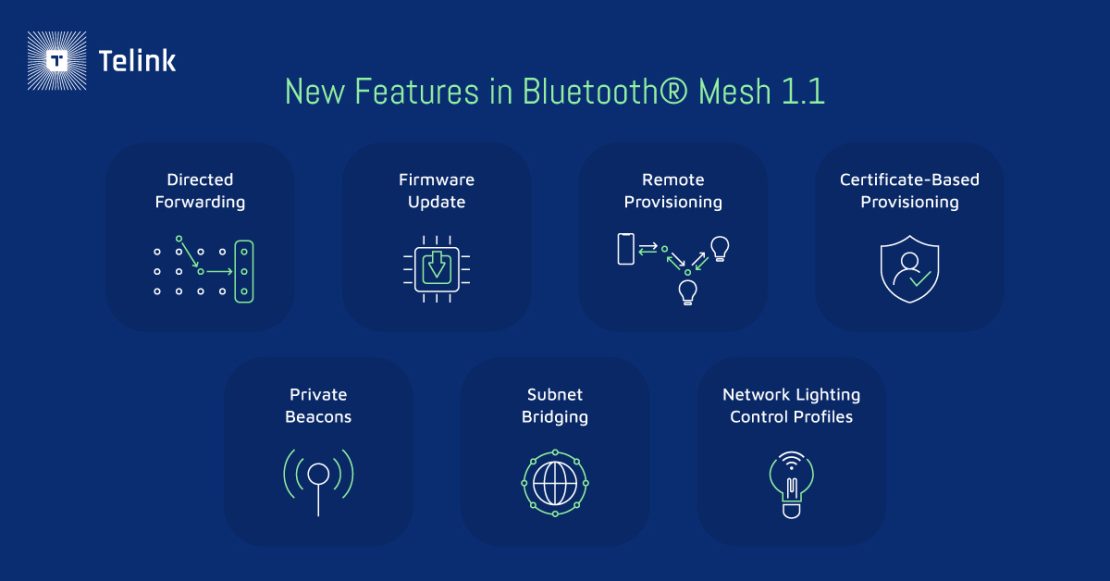



PLEASE ROTATE ME


Telink Staff
October 10, 2023
Standards

With new features and greater interoperability than before, Bluetooth Mesh 1.1 transforms our current digital environment to meet today’s consumer needs.
Ever since its inception, Bluetooth® technology has been a marvel for short-range wireless communication. However, its traditionally point-to-point nature meant it was inherently limited in range and flexibility — that is until Bluetooth® Mesh entered the picture. Instead of restricting devices to communicate in a simple pair, Bluetooth Mesh allows devices to form a network, where messages hop from one node to another, ultimately extending communication ranges and providing better reliability.
Recently, the Bluetooth Special Interest Group (SIG) released the latest version of Bluetooth Mesh: the Bluetooth® Mesh 1.1 Protocol Specification. While Bluetooth Mesh 1.0 laid the foundation for establishing mesh networks tailored for medium-scale applications, provided basic security features and fundamental tools for network monitoring, its 1.1 iteration takes all these capabilities a step further for future-proof functionality, security, and convenience.

Bluetooth Mesh 1.1 brings improved scalability, interoperability, and performance through the following new and enhanced features:
In addition to the above-mentioned main enhancement features, another significant update in Bluetooth Mesh 1.1 is the introduction of NLC (Network Lighting Control) Profiles. This protocol standardizes common scenarios for smart lighting, further promoting interoperability among devices. The NLC Profiles are divided into 6 sub-profiles:
These profiles define the use of sensing devices such as ambient light sensors and occupancy sensors, controllers for brightness adjustment, and controllers for scene-triggered events. They also establish unified standards for the functionalities that lighting devices should support, facilitating manufacturers in promoting and implementing interoperable products.
Telink now supports all the functional updates and NLC Profiles of the Bluetooth Mesh 1.1 standard with its SoC products. This advancement is designed to assist customers in enhancing the overall user experience of smart devices comprehensively.
Achieving comprehensive support for Bluetooth Mesh 1.1 is another significant milestone for Telink, marking the company’s consistent leadership in the forefront of research and development in wireless connectivity technologies for the Internet of Things. As a leading enterprise in IoT wireless connectivity System-on-Chip (SoC), Telink introduced its Bluetooth Low Energy-based proprietary Mesh technology as early as 2015, successfully realizing large-scale commercial use ahead of the market. In 2017, Telink’s products promptly supported the Bluetooth Mesh 1.0 standard specification introduced by the Bluetooth SIG. Since then, Telink has continued its commitment to the latest Bluetooth Mesh technology. In the Mesh 1.1 standard Interoperability (IOP) verification, Telink contributed to over 25% of the results, proposed modifications, and was honored with the IOP Outstanding Contribution Award by the Bluetooth SIG.
If you’re a developer eager to dive into the world of Bluetooth Mesh and leverage the advantages of the 1.1 Protocol Specification, Telink is your ideal partner. With our state-of-the-art SOCs, Telink ensures that any product you develop is not just compatible with the Bluetooth Mesh ecosystem but optimized for peak performance.
Please visit our wiki to learn more, or ask us a question through our Technical Forum or by contacting us directly today.